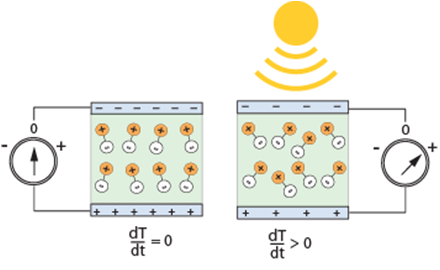 |
Pyroelectric coefficient (μC/m2.K): The change in polarization ΔP caused by a change of temperature ΔT is given by
ΔP=γΔT
where γ is the pyroelectric coefficient. Thus
![]()
Two figures-of-merit are used to characterize pyroelectrics: the voltage responsivity (Fv) and the specific detectivity (FD)


Here γ is the pyro-electric charge coefficient, Cp the specific heat, εr the dielectric constant and tan δ the dielectric loss tangent. Above the Curie temperature Tc the polarization is lost completely. These are the parameters used for selection.
Electrocaloric effect: The equivalent reverse effect is known as the electrocaloric effect. It describes the change in temperature caused by a change of electric field across the material.
Applications: Pyroelectric materials are used in temperature sensors, infra-red detectors and thermal imaging. Examples are IR burglar alarms and thermal imaging for photography of wild life at night - in both cases the heat radiated by the causes a change in the polarization at the detector or image-pixel. Compared to alternative semiconductor devices, pyroelectric materials have a strong response across a wide frequency spectrum, are effective at room temperature and have a faster response time.
Ashby, Michael, Shercliff, Hugh and Cebon, David. Materials: Engineering, Science, Processing and Design. s.l. : Elsevier, 2014.
Chung, Deborah D.L. Functional Materials: Electrical, Dielectric, Electromagnetic, Optical and Magnetic Applications. s.l. : World Scientific, 2010.
Uchino, Kenji. Ferroelectric Devices. s.l. : Marcel Dekker, Inc., 2000
Haertling, Gene H. Ferroelectric Ceramics: History and Technology. 4, 1999, J. Am. Ceram. Soc., Vol. 82, pp. 797-818.
Copyright © 2020, Granta Design Limited, a subsidiary of ANSYS, Inc.